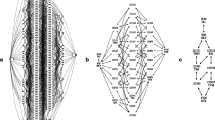Abstract
Among-site rate variation, as quantified by the gamma-distribution shape parameter,a or α, and the ratio of transition rate to transversion rate (Ts/Tv) influence phylogenetic inference. We examine the effect of topology on estimates of these two parameters in 12S rRNA sequences from nine species of mice belonging to the generaOnychomys andPeromyscus by generating 100 random topologies and estimating these parameters using parsimony and maximum-likelihood methods for each of the random topologies. The parsimony-based estimate ofTs/Tv from the well-corroborated topology falls within the distribution of estimates based on random topologies, whereas the maximum-likelihood estimate ofTs/Tv based on the well-corroborated topology lies well outside the distribution of estimates derived from random topologies. TheTs/Tv ratio derived via maximumlikelihood estimation is three times the parsimony-based estimate, suggesting that parsimony-based estimates are severe underestimates even when the correct topology is used. Both parsimony- and likelihood-based estimates of the gamma-distribution shape parameter (α) are sensitive to topology because the best estimates based on the well-corroborated topology are well outside the distributions of estimates derived from random topologies for both methods. We show that the reason for topology dependence is the presence of long internal branches in the underlying topology.
Similar content being viewed by others
References
Farris JS (1969) A successive approximations approach to character weighting. Syst Zool 18:374–385
Gaut BS, Lewis PO (1995) Success of maximum likelihood phylogeny inference in the four-taxon case. Mol Biol Evol 12:152–162
Kocher TD, Wilson AC (1991) Sequence evolution of mitochondrial DNA in human and chimpanzees: control region and protein coding region. In: Osawa S, Honjo T, (eds) Evolution of life: fossils, molecules, and culture. Springer, Tokyo, pp 391–413
Kuhner MK, Felsenstein J (1994) A simulation of phylogeny algorithms under equal and unequal evolutionary rates. Mol Biol Evol 11:459–468
Maddison WP, Maddison DR (1992) MacClade: analysis of phylogeny and character evolution. Version 3.0. Sinauer Associates, Sunderland, MA
Sullivan J, Holsinger KE, Simon C (1995) Among-site rate variation and phylogenetic analysis of 12S rRNA in Sigmodontine rodents. Mol Biol Evol 12:988–1001
Tateno Y, Takezaki N, Nei M (1994) Relative efficiencies of the maximum likelihood, neighbor joining, and maximum parsimony methods when substitution rate varies with site. Mol Biol Evol 11:261–277
Wakeley J (1994) Substitution-rate variation among sites and the estimation of transition bias. Mol Biol Evol 11:426–442
Williams PL, Fitch WM (1990) Phylogeny determination using the dynamically weighted parsimony method. Methods Enzymol 183:615–627
Yang Z (1994) Maximum likelihood phylogenetic estimation from DNA sequences with variable rates over sites: approximate methods. J Mol Evol 39:306–414
Yang Z, Goldman N, Friday A (1994) Comparison of models for nucleotide substitution used in maximum-likelihood phylogenetic estimation. Mol Biol Evol 11:316–324
Author information
Authors and Affiliations
Rights and permissions
About this article
Cite this article
Sullivan, J., Holsinger, K.E. & Simon, C. The effect of topology on estimates of among-site rate variation. J Mol Evol 42, 308–312 (1996). https://doi.org/10.1007/BF02198857
Received:
Accepted:
Issue Date:
DOI: https://doi.org/10.1007/BF02198857




